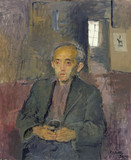Raphael Soyer was one of the most respected figure painters in America during the years between the two world wars, best known for his depression-period scenes of life in New York and his figure studies of friends, dancers, and actors posed in his studio. The Soyer family-which included Raphel’s twin brother MOSES and younger brother Isaac (1902-1981), both of whom became artists-immigrated to the United States in 1912 and settled in the New York borough of the Bronx. While working to help support them, Raphael studied at various art schools: for three years at the Cooper Union, then from 1917 to 1922 at the National Academy of Design, and occasionally during the early 1920s at the Art Students League, studying there with both Guy PÉNE DU Bois and Boardman Robinson (18761952). He first exhibited at the Salon of America in 1926 and soon became a frequent contributor to the Whitney Studio Club, receiving the patronage of its director, Juliana Force. In 1929 his first solo exhibition at the Daniel Gallery met with much success.
In the 1930s and 1940s Soyer was very active, exhibiting regularly in the major museum annuals and in solo shows at a variety of New York galleries as well as working on the graphic arts and mural divisions of the Works Progress Administration/Federal Art Project. In 1930 he also began his career as a teacher, which lasted more than thirty years and included positions at the Art Students League, the New School for Social Research, and the National Academy of Design, all in New York.
Although identified with New York City art circles, Soyer summered in the country: in the late 1920s and early 1930s in Gloucester and Provincetown, Massachusetts, and Ogunquit, Maine; during the 1940s in Croton-on-Hudson, New York; and from 1957 in Vinalhaven, Maine. In later years he also traveled frequently, visiting Europe and Russia and publishing three books inspired by what he saw: A Painter’s Pilgrimage (1962), Homage to Thomas Eakins, Etc. (1966), and Self-Revealment (1969). He continued to paint until the end of his life but never substantially altered his style formed during the 1930s. Always maintaining his desire "to be a realist and a humanist in art," Raphael Soyer was instrumental in organizing a group of like-minded artists who published the annual Reality, 1953-55.
BIBLIOGRAPHY
Archiv. Am. Art, Raphael Soyer Papers § Harry Salpeter, "Raphael Soyer: East Side Degas," Esquire 9 (May 1938): 58-61, 155-58 § Lloyd Goodrich, Raphael Soyer (New York: Harry N. Abrams, [c. 1972]), with statements by the artist, biographical note, list of solo exhibitions, bibliography § Raphael Soyer, Diary of An Artist (Washington, D.C.: New Republic Books, 1977), compilation from previous publications, A Painter’s Pilgrimage (1962), Homage to Thomas Eakins, Etc. (1966), and Self-Revealment (1969) § Washington, D.C., Smithsonian Institution, Hirshhorn Museum and Sculpture Garden, Soyer Since 1960, exh. cat., 1982, published by Smithsonian Institution Press, with essay by Abram Lerner.

